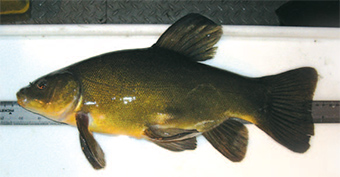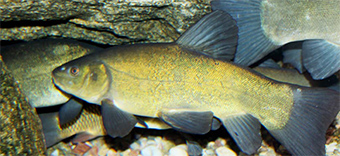Tench
Learn about tench and how you can help prevent the introduction and spread of this invasive species.
What Ontario is doing
To prevent this unwanted invader from coming into the province, Ontario has regulated tench (Tinca tinca) as a prohibited invasive species under the Invasive Species Act, 2015.
Learn about the Invasive Species Act and regulations.
Background
Tench are a medium-sized fish that live in shallow, slow-moving freshwater systems with dense vegetation. They can survive in a wide range of environmental conditions, including:
- clear or muddy waters
- low oxygen levels
- temperatures ranging from 4°C to 24°C
Their ability to survive in many habitats, along with their ability to consume a wide range of species, contributes to the negative impacts when they invade new ecosystems.
Although not typically sold in Ontario, tench is available for sale online in other jurisdictions and may be intentionally released as an ornamental, food, or sport fish.
Tench can also be illegally used as bait for anglers, which may lead to accidental release.
Range
Tench are native to temperate areas of Europe and Asia but have been introduced widely beyond its native range, including North America, Africa and Australia
In Canada, tench have become established in the Columbia River system in British Columbia and Richelieu River, and have also been found in the St. Lawrence River in Quebec.
Although tench have been captured in Lake St. Francis, which straddles the Ontario-Quebec border, no breeding populations of tench have been detected.
View an up-to-date distribution map of Tench in North America.
Impacts of tench
Tench are bottom feeders and consume large amounts of snails and crustaceans. Tench may out compete native minnows, bullheads, and suckers for food. Their aggressive feeding habits can stir up sediment, reducing water quality and degrading aquatic habitats.
The impacts on aquatic habitats can negatively affect native species of fish.
How to identify tench
Tench are on average 20 to 25 cm long with a deep and slightly compressed body. The tench body colour is dark olive to pale golden tan, with a white to bronze belly and a bright reddish-orange eye.
The mouth forms the front tip of the head and has a single whisker (known as a barbel) hanging at each corner. the fins are dark and rounded, with no spines, while the scales are small and embedded in thick skin.
Similar species key identification features
Tench resembles other native and introduced members of the minnow family, but only tench have a deep body with small scales, and a barbel at each corner of the mouth.
What you need to know
- Learn how to identify tench and how to prevent the introduction or spread of this fish to local waterways.
- It is illegal to import, deposit, release, possess, transport, propagate, buy, sell or trade tench in Ontario.
- Never buy or use tench as bait or release any live fish into Ontario waterbodies.
Reporting illegal activity
If you have any information about the illegal importation, distribution, or sale of tench, report it immediately to either:
- the ministry at
1-877-847-7667 , toll-free anytime - Crime Stoppers anonymously at
1-800-222-TIPS (8477)
If you’ve seen Tench or another invasive species in the wild, please:
- contact the toll free Invading Species Hotline at
1-800-563-7711 - visit EDDMapS Ontario
- search for the ‘Invasive Species in Ontario’ project on iNaturalist.org to report a sighting
Gallery

Photo: Alan Butterworth

Photo: Shawn P. Good, Vermont Fish and Wildlife Department)

The tench body is dark olive to pale golden tan above, with a white to bronze belly.
Photo: Wikipedia Commons